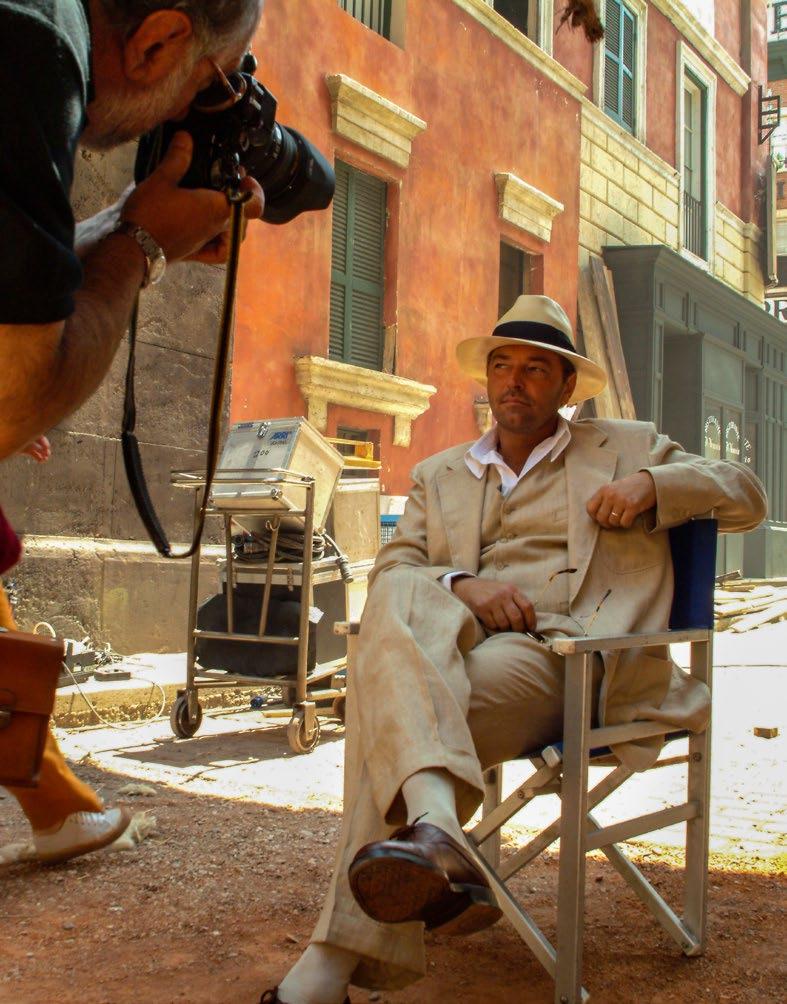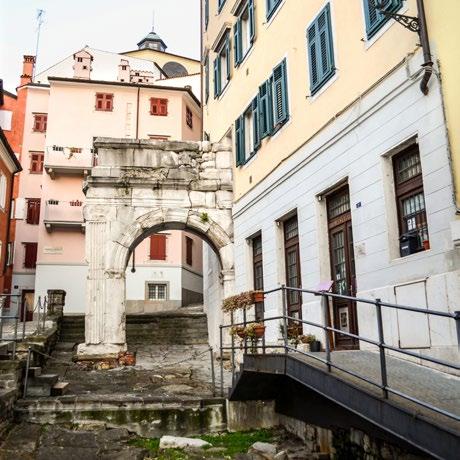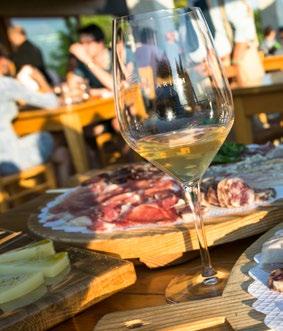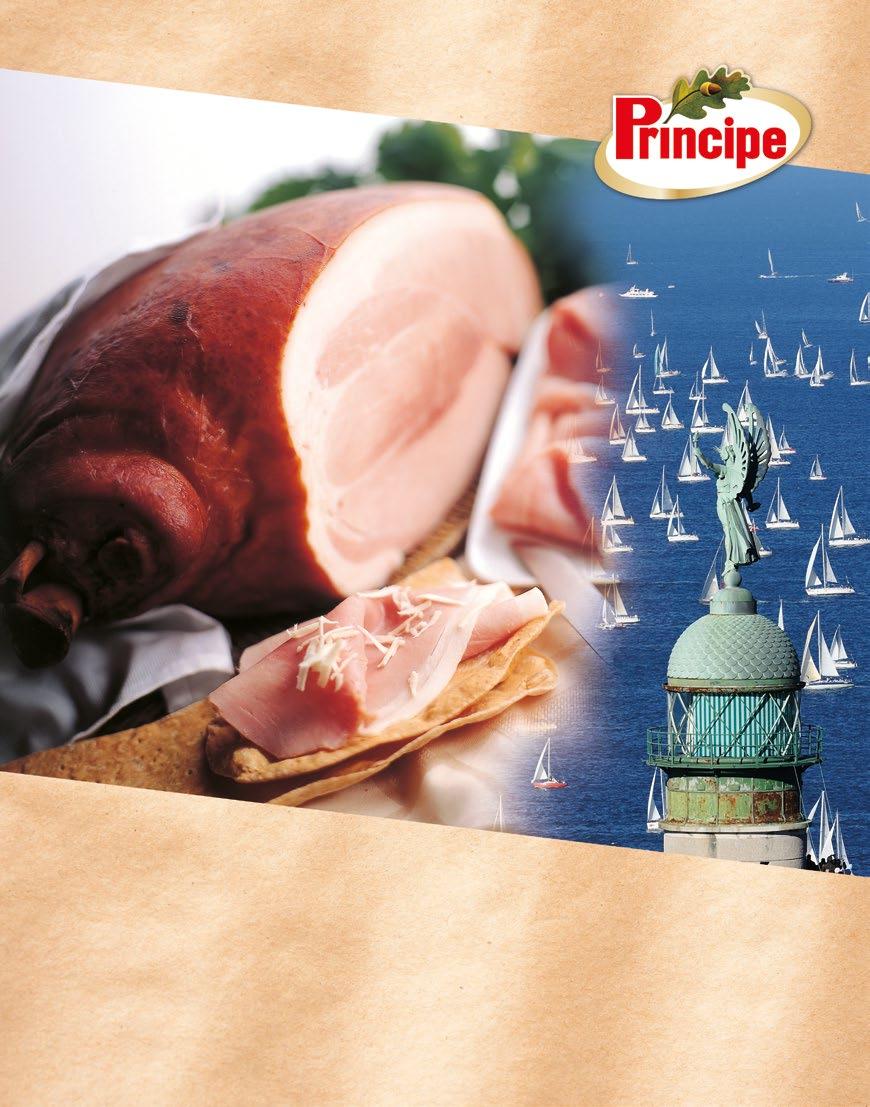
8 minute read
COLORI PER LEGGERE UN’ANIMA
from number 1
di /by Giovanni Marzini
Di Trieste ti innamori subito per la sua luce, che ha un’anima, nella sua particolare intensità che traspare nello spaccato di quelle colline che paiono tuffarsi dentro il mare, regalandoti atmosfere forti, che non hanno uguali…” Trasudano sincero amore per questa città le parole di Sebastiano Somma, attore napoletano legato a Trieste dalle tappe più felici e importanti all’inizio della sua carriera televisiva, con due fiction che gli hanno regalato un immediato successo e l’amore del pubblico. Merito in parte anche dei personaggi che ha interpretato: il commissario Giovanni Palatucci in “Senza confini”, la storia di un poliziotto italiano al quale centinaia di ebrei devono la vita ai tempi delle leggi razziali, e l’avvocato Rocco Tasca delle cinque serie TV “Un caso di coscienza”, paladino dei più deboli in una Trieste contemporanea.
Advertisement
“Sono state queste due importanti produzioni RAI a farmi conoscere e amare questa città. Con i miei genitori e mia sorella l’avevo conosciuta quando avevo 14 anni. Una breve vacanza, della quale conservo solo il ricordo della visita al castello di Miramare e di un delizioso ristorante lì vicino. Ma l’amore vero sarebbe scoppiato negli anni Duemila, vestendo i panni di Palatucci nelle scene girate tra Fiume, Abbazia e appunto Trieste. Non è un caso, se nel corso degli anni il primo posto dove vado quando arrivo a Trieste è la città vecchia, la zona di Cavana. In particolare una casa a fianco dell’arco di Riccardo. Al primo piano avevamo individuato la location per il piccolo appartamento dove viveva Palatucci, con una finestra che affacciava sulla piazzetta sottostante. Ritornarci mi regala ancor oggi un’emozione intensa. Ed è questo il percorso cittadino che consiglio a chi vuole entrare nell’anima di Trieste. Partire dal castello di San Giusto, sul colle che domina il centro storico, e scendere tra i vicoli che portano alla città vecchia, che regalano squarci di grande romanticismo. Per poi scendere fino al mare e approdare sulle rive. Qui iniziava il mio percorso di jogging, che non ha eguali. Ma –mi raccomando– arrivate fino all’estremità opposta del fronte mare, quasi all’ingresso del porto nuovo. Ricordo che una tappa obbligata era quella del piccolo molo sotto la Lanterna: soprattutto all’ora del tramonto regala colori e sensazioni che nessuna macchina fotografica può catturare.”

Ma la Trieste di Sebastiano Somma esce anche dai confini della città e s’arrampica oltre il ciglione carsico. “È quella che ancora adesso mi piace di più. Forse per quello che respiri tra le pietre e le foglie del Carso. Ti raccontano un pezzo della nostra storia: lo rivedi, lo annusi, lo ascolti nel dialetto dei vecchi che puoi incontrare seduti a un tavolo nelle osmize dei piccoli borghi che puntellano l’altopiano sopra la città. Un bicchiere di vino aspro, duro il Terrano, più morbida la Malvasia, una fetta di prosciutto crudo tagliato a mano, un uovo sodo piuttosto che un pezzo di formaggio. Ringrazio gli amici triestini che mi hanno fatto conoscere tutto ciò.”
Sebastiano Somma, 57 anni, nato a Castellamare di Stabia (Napoli), è un attore che ha diviso la sua carriera tra cinema, televisione e molto teatro. Sposato con un’attrice, Morgana, che gli ha regalato una deliziosa figlia di nome Cartisia, deve la sua grande popolarità soprattutto ad alcune fiction per la televisione trasmesse da RAI e Mediaset. Ormai profondamente legato alla città di Trieste, tanto da ricevere tempo fa il ‘Sigillo d’oro’ dalle mani del sindaco Roberto Dipiazza, Somma ha legato il suo nome come testimonial della Fondazione Luchetta, partecipando alle prime edizioni de “I nostri angeli”, il galà televisivo con la premiazione dei vincitori del Premio giornalistico internazionale Marco Luchetta.
Sebastiano Somma, 57, was born in Castellamare di Stabia, near Naples. He is an actor whose career spans work in the cinema, television and theatre, although his fame is largely due to his work in popular RAI and Mediaset dramas. He is married to fellow actress Morgana and they have a lovely daughter called Cartisia. Sebastiano has a very strong connection with Trieste –so much so that he has recently received the Sigillo d’oro (lit. gold Seal) from the city mayor, Roberto Dipiazza. Not only this, Somma is a spokesperson for the Fondazione Luchetta. He took part in the first editions of “I nostri angeli” (lit. Our Angels), the televised award ceremony for the Marco Luchetta International Press Award.
Già, Trieste e la sua scontrosa grazia, Trieste e i triestini, che ti abbracciano ma non ti stringono… “Da napoletano, quindi da buon terrone…, rappresento una gente aperta, che fa del vivi e lascia vivere la sua filosofia; dovrei quindi essere in conflitto con gli abitanti di Trieste, una città che ha vissuto per anni quasi ai margini del nostro Paese e che di conseguenza ha una naturale diffidenza a farti entrare. Eppure se mi chiedete di disegnare un identikit del triestino, ne esce una persona un po’ testarda, follemente simpatica e fortemente colorata. Proprio come la luce di questa città. Questo intendevo quando dicevo che attraverso i colori di Trieste leggi la sua anima. E non è un caso che questa città sia non solo una tappa, ma spesso anche una meta per artisti e scrittori, persone che non si fermano all’apparenza ma che in questi luoghi si ritrovano…”.
Le passeggiate di
Dal castello di San Giusto [1] (il modo più comodo per raggiungerlo a piedi è con l’ascensore del Park San Giusto, con ingresso da via del Teatro Romano) un percorso suggestivo è quello che dal colle, dopo aver visitato castello e Cattedrale [2], vi porta in discesa verso il centro città, percorrendo inizialmente via della Cattedrale. Potete poi scegliere tutta una serie di vicoli sino alla città vecchia, negli anni in gran parte recuperata con interventi edilizi che non ne hanno snaturato la storia.
Il percorso jogging è invece quello che si affaccia sul mare: può iniziare dal molo Audace [3], lungo il water-front che costeggia le marine sino alla Lanterna, quasi all’ingresso del porto nuovo, ma può svilupparsi con distanze più consistenti anche sul lato opposto, verso il Porto Vecchio [4], per una corsa (o una lunga passeggiata) all’interno del vecchio scalo di Maria Teresa d’Austria.
“With Trieste, it’s love at first sight. The place has a special intensity of light that shines on hills that look as though they are diving head first into the sea. It has a special ambience like no other place I know…” So speaks Neapolitan actor Sebastiano Somma of his heartfelt love for the city. He links Trieste with some of the happiest and most important moments at the beginning of his television career, with two drama series that enjoyed immediate success and were loved by Italian TV viewers. Somma’s popularity was also partly thanks to the characters he played: Commissioner Giovanni Palatucci in “Senza Confini”, the story of an Italian police officer who saved the lives of hundreds of Jews during the times of racial laws; and Rocco Tasca, a lawyer who defends the weak in modern-day Trieste in the 4-season series “Un caso di coscienza”.
“It was these two important RAI productions that helped me to get to know and then fall in love with this city, although I actually came here for the first time when I was 14 with my parents and my sister. We had a short holiday; the only thing I remember of it was the visit to Miramare Castle and a gorgeous restaurant nearby. But I really fell in love with the place in the early 2000’s when I was playing the role of Palatucci in the scenes filmed in Rijeka, Opatija and of course Trieste. The first place I visit whenever I come back to Trieste is the Old Town, the area called Cavana
After visiting San Giusto castle and the cathedral [1] (the best way to get there is on foot using the lift in the Park San Giusto car park, entrance on via del Teatro Romano) a pleasant walk can be taken from San Giusto hill to the city centre, along Via della Cattedrale [2]. Then you can choose from the many narrow streets leading to the historic old town, which has recently undergone careful restoration. If jogging is your thing, then you can run by the sea. Start from the Molo Audace [3], run along the waterfront and past the marinas until you reach the Lanterna, almost at the entrance of the new port. For a longer distance, double back yourself on the opposite side of the road, towards the Porto Vecchio [4] for a run (or a long walk) inside the old port which once belonged to Maria Theresa of Austria.
There’s a house next to the Arco di Riccardo, where there is a small first floor flat that we picked out as the location for Palatucci’s home, with a window looking out onto the square below. Going there always brings back such strong emotions. I would recommend going there to anyone who really wants to feel the heart and soul of Trieste. It’s better to start from San Giusto castle, the hill which dominates the old part of the city, and walk down through the narrow streets that lead to the old town, there are some lovely little alleyways. Then all these little streets take you down to the waterfront and finally the sea. This is where I used to go jogging, there’s no better place. But make sure you go as far as you can, almost as far as the entrance to the new port. I fondly remember stopping at a little pier under the Lanterna lighthouse –you get unbeatable views of breathtaking sunsets that no photograph could ever capture.”
Sebastiano Somma’s beloved Trieste goes beyond the city limits and climbs up into the Karst. “That’s something that I enjoy even more now. Maybe it’s the air that you breathe up there amongst the rocks and leaves of the Karst. They tell you a piece of our history: you relive it, you breathe it, you can hear it in the dialect of the elderly people that you meet as they sit at tables in osmize in the small villages that are dotted around the hills above the city. A glass of robust, dry red wine, tough Terrano or smoother Malvasia, a slice of hand-carved Parma ham, a boiled egg or a piece of cheese. I have my Triestino friends to thank for showing me all of this.”
It’s true, as Saba put it so well… Trieste and her ‘surly grace’, Trieste and the Triestini, that hold you but never too tight… “Coming from Naples, and so from the South of Italy, I come from a land of open-hearted people who have ‘live and let live’ as their philosophy. In theory I should find the Triestini hard to get along with: it’s a city that has lived for years at the edges of our country and so has a natural reluctance to let strangers in. But still, if you ask me to describe the identikit of the Triestino, I would describe someone who is slightly headstrong, extremely likeable and very colourful. Just like the light of this city. That’s what I mean when I say that the colours of Trieste show its soul. It’s not by chance that this city isn’t just a stopover but a destination for artists and writers, people that don’t just judge by appearances and who find themselves in these places…”.
What are these osmize?
Tanto amate da Somma, le osmize sono una sorta di piccola trattoria a conduzione familiare che può mettere in vendita vino e prodotti gastronomici prodotti direttamente dagli stessi gestori. Si trovano in prevalenza sull’altipiano carsico o nell’immediata periferia della città. Risalgono a quando Trieste era una città dell’impero austro-ungarico; il nome “osmiza” deriva dal fatto che in origine potevano restare aperte per non più di otto giorni consecutivi, in alcuni periodi dell’anno. La tradizione in tal senso continua, con aperture scaglionate, in prevalenza nel periodo primavera-estate. Per vedere quali sono quelle aperte è nato anche un sito web, www.osmize.com
What are these osmize that Somma loves so dearly? They are a sort of small, familyrun trattoria that is allowed to sell wine and (only) home grown produce and are found in the Carso uplands or country villages near to the city. The osmize date back to when Trieste was still part of the Austro-Hungarian empire and the name osmiza comes from the fact that they were originally only allowed to stay open for no more than 8 consecutive days, in specified periods of the year. The tradition continues today, with staggered opening times (mainly in Spring and Summer) that can be found on www.osmize.com








